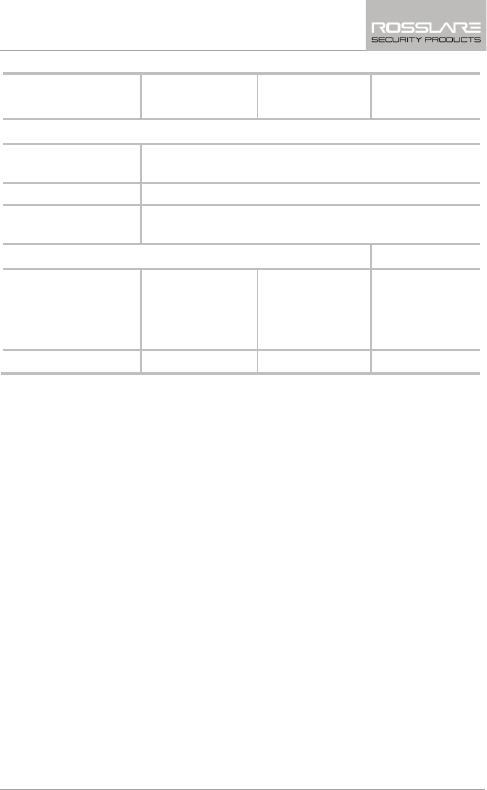User's Manual
Table Of Contents
- 1. General Information
- 2. Technical Specifications
- 3. Installation
- 4. Wiring Instructions
- 5. Reader Functionality
- 5.1 Transmit Mode
- 5.2 Programming the AYC-Ex5 and AYC-T65
- 5.2.1 Entering Programming Mode
- 5.2.2 Exiting Programming Mode
- 5.2.3 Selecting Keypad Transmission Format
- 5.2.3.1 Keypad Transmission Format Option Number
- 5.2.3.2 Option 1: Single Key, 6-Bit Wiegand (Rosslare Format)
- 5.2.3.3 Option 2: Single Key, 6-Bit Wiegand Nibble and Parities
- 5.2.3.4 Option 3: Single Key, 8-Bit Wiegand Nibbles Complemented
- 5.2.3.5 Option 4: 4 Keys Binary + Facility Code, Wiegand 26-Bit
- 5.2.3.6 Option 5: 1 to 5 Keys + Facility Code, Wiegand 26-Bit
- 5.2.3.7 Option 6: 6 Keys BCD and Parity Bits, Wiegand 26-Bit
- 5.2.3.8 Option 7: Single Key, 3x4 Matrix Keypad (MD-P64)
- 5.2.3.9 Option 8: 1 to 8 Keys BCD, Clock & Data
- 5.2.4 Selecting Proximity Card Transmission Format
- 5.2.5 Changing the Programming Code
- 5.2.6 Changing the Facility Code
- 5.3 Setting the Backlight
- 6. Controller Functionality
- 6.1 Normal, Secure, and Master Users
- 6.2 Modes of Operation
- 6.3 Auxiliary Input & Output
- 6.4 Door Alarms
- 6.5 Internal Case and Back Tamper
- 6.6 Lockout Feature (Keypad Tamper)
- 6.7 Request to Exit (REX) Function
- 6.8 Secure Application Appurtenances
- 6.9 Programming the AYC-Ex5 and AYC-T65
- 6.9.1 Entering Programming Mode
- 6.9.2 Exiting Programming Mode
- 6.9.3 Changing Lock Strike Code
- 6.9.4 Changing Auxiliary Code
- 6.9.5 Changing the Programming Code
- 6.9.6 Changing the Normal/Secure Code
- 6.9.7 Changing the Normal/Bypass Code and Door Chime Settings
- 6.9.8 Setting Fail Safe/Secure Operation, Tamper Siren and Lock Strike Release Time
- 6.9.9 Defining the Auxiliary Input and Output
- 6.9.10 Detailed Reference Guide
- 6.9.11 Setting the Lockout Feature
- 6.9.12 Setting the Backlight Behavior
- 6.9.13 Enrolling Primary and Secondary Codes
- 6.9.14 Deleting Primary and Secondary Codes
- 6.9.15 Relay Codes Assignment
- 6.9.16 Relay Code Assignment using Standard Method
- 6.9.17 Relay Code Assignment using Search Method
- 6.9.18 PIN Code Length/Factory Default Settings
- 6.9.19 Replacing a Lost Programming Code
- 6.9.20 Exiting Secure Mode if Normal/Secure Code was Lost
- A. Declaration of Conformity
- B. Limited Warranty

Technical Specifications
AYC-Ex5 and AYC-T65 Installation and Programming Manual 13
Specification AYC-E55 AYC-E65B,
AYC-E65BB
AYC-T65
Environmental Characteristics
Operating Temp.
Range
-22°F to 150°F (-30°C to 65°C)
Operating Humidity
0 to 95% (non-condensing)
Outdoor Usage
Weather-resistant, meets IP-68, epoxy potted, suitable
for outdoor use
Physical Characteristics
Size
(Height x Width x
Depth)
155 x 44 x 6.5
mm
(6.1 x 1.73 x
0.256 in.)
155 x 44 x 9 mm
(6.1 x 1.73 x
0.354 in.)
121 x 70 x 8 mm
(4.77 x 2.76 x
0.31 in.)
Weight
120 g (0.265 lb) 143 g (0.315 lb) 121 g (0.27 lb)
* Measured using Rosslare proximity card (AT-14) or equivalent. Range also
depends on electrical environment and proximity to metal.
2.1 Key Features
The key features for the AYC-Ex5 and AYC-T65 series are:
Ultra-slim flush-mount design on flat surface
Built-in piezoelectric keypad for PIN code entry
Built-in 125 KHz ASK EM proximity card reader (AYC-E65B, AYC-
E65BB, AYC-T65)
Programmable patented blue backlit keypad (AYC-E65B, AYC-
E65BB, AYC-T65)
Optical back tamper sensor and open collector tamper output
Lockout feature on wrong entries (keypad tamper)
Internal buzzer provides audible interface feedback
Two status/programming interface LEDs (tri-colored)
Fully potted construction for outdoor use










